ESP TOYOTA AYGO 2015 Owners Manual (in English)
[x] Cancel search | Manufacturer: TOYOTA, Model Year: 2015, Model line: AYGO, Model: TOYOTA AYGO 2015Pages: 440, PDF Size: 22.97 MB
Page 27 of 440
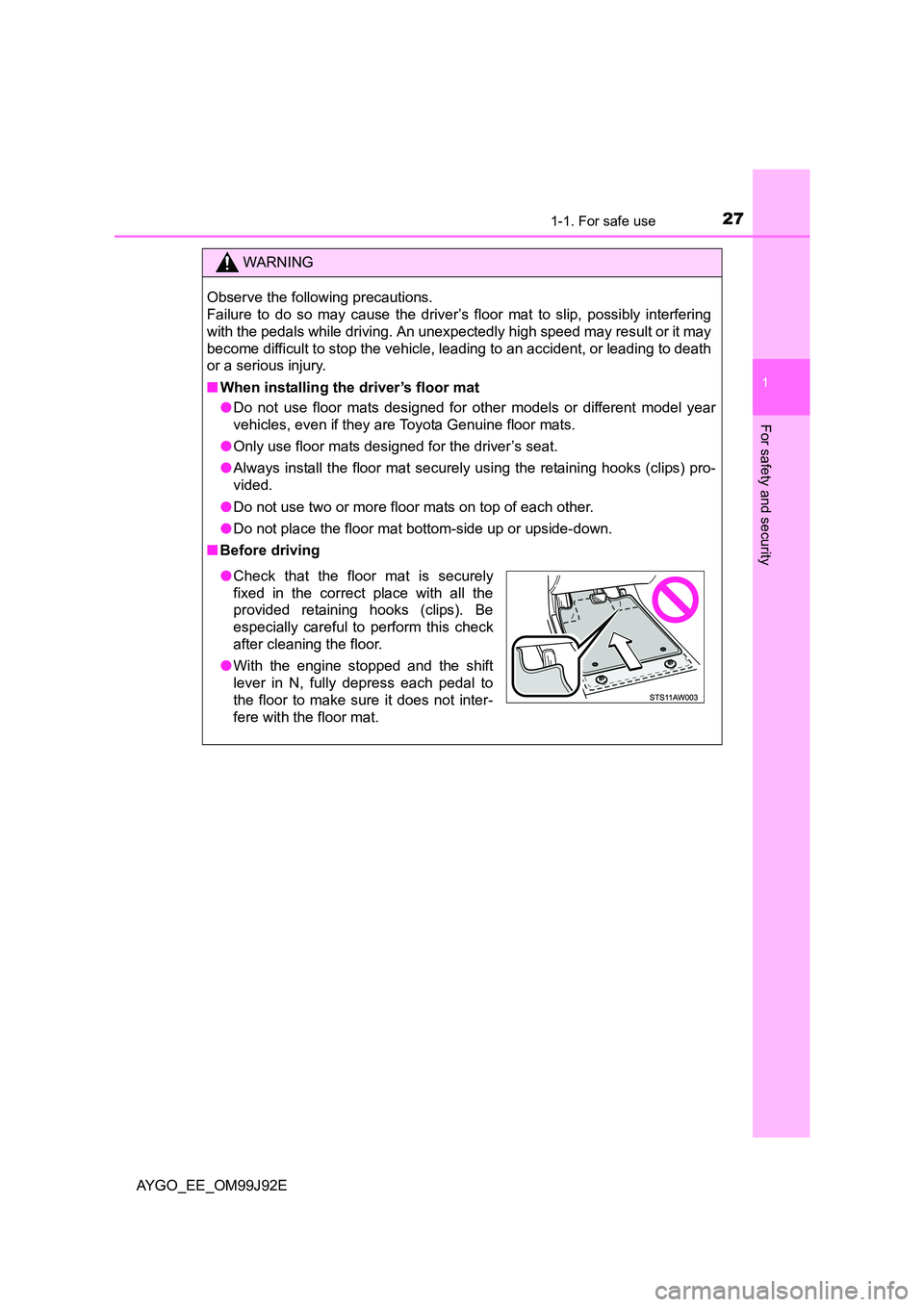
271-1. For safe use
1
For safety and security
AYGO_EE_OM99J92E
WARNING
Observe the following precautions.
Failure to do so may cause the driver’s floor mat to slip, possibly interfering
with the pedals while driving. An unexpectedly high speed may result or it may
become difficult to stop the vehicle, leading to an accident, or leading to death
or a serious injury.
■ When installing the driver’s floor mat
● Do not use floor mats designed for other models or different model year
vehicles, even if they are Toyota Genuine floor mats.
● Only use floor mats designed for the driver’s seat.
● Always install the floor mat securely using the retaining hooks (clips) pro-
vided.
● Do not use two or more floor mats on top of each other.
● Do not place the floor mat bottom-side up or upside-down.
■ Before driving
●Check that the floor mat is securely
fixed in the correct place with all the
provided retaining hooks (clips). Be
especially careful to perform this check
after cleaning the floor.
● With the engine stopped and the shift
lever in N, fully depress each pedal to
the floor to make sure it does not inter-
fere with the floor mat.
Page 37 of 440
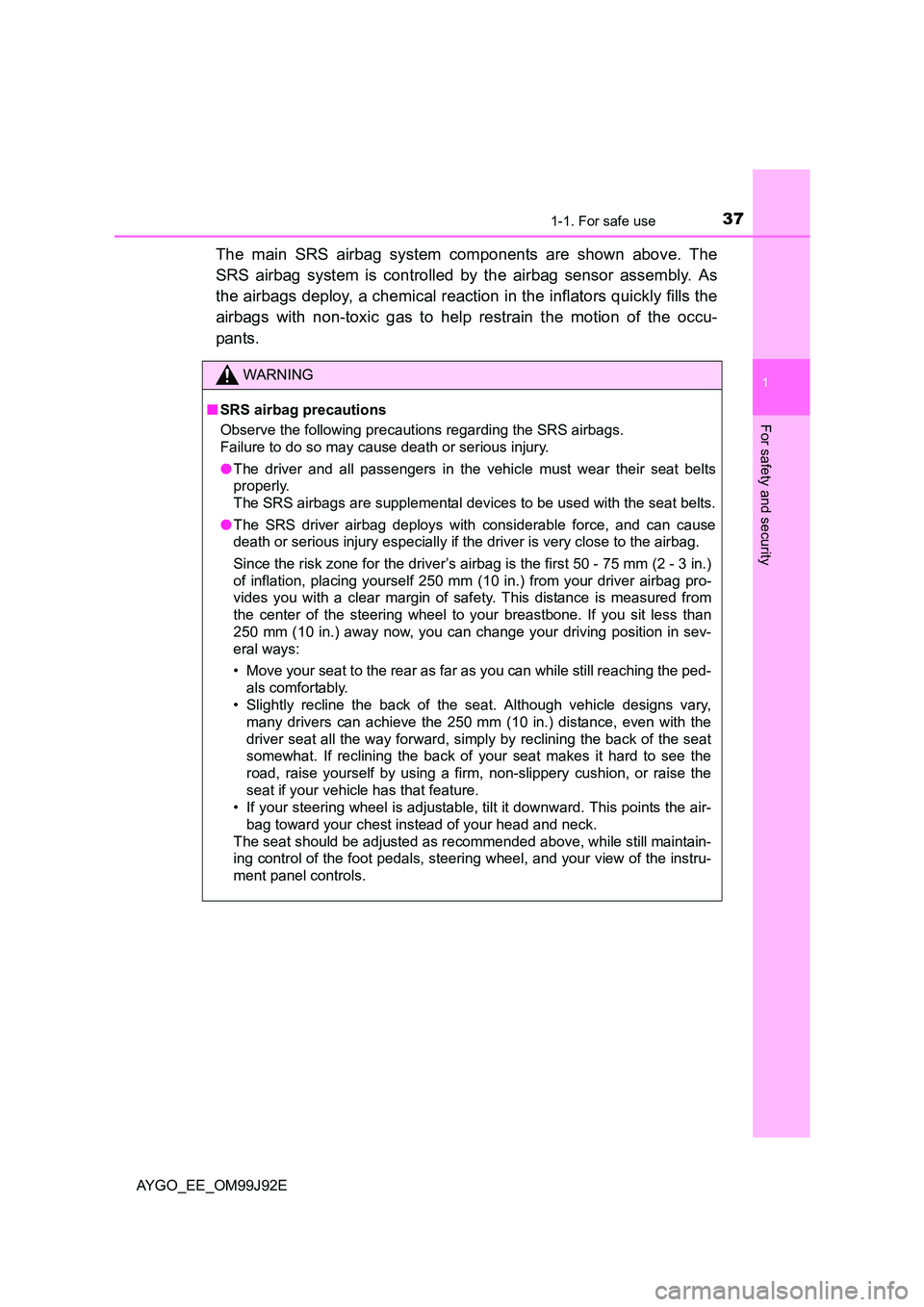
371-1. For safe use
1
For safety and security
AYGO_EE_OM99J92E
The main SRS airbag system components are shown above. The
SRS airbag system is controlled by the airbag sensor assembly. As
the airbags deploy, a chemical reaction in the inflators quickly fills the
airbags with non-toxic gas to help restrain the motion of the occu-
pants.
WARNING
■ SRS airbag precautions
Observe the following precautions regarding the SRS airbags.
Failure to do so may cause death or serious injury.
● The driver and all passengers in the vehicle must wear their seat belts
properly.
The SRS airbags are supplemental devices to be used with the seat belts.
● The SRS driver airbag deploys with considerable force, and can cause
death or serious injury especially if the driver is very close to the airbag.
Since the risk zone for the driver’s airbag is the first 50 - 75 mm (2 - 3 in.)
of inflation, placing yourself 250 mm ( 10 in.) from your driver airbag pro-
vides you with a clear margin of safety. This distance is measured from
the center of the steering wheel to your breastbone. If you sit less than
250 mm (10 in.) away now, you can change your driving position in sev-
eral ways:
• Move your seat to the rear as far as you can while still reaching the ped-
als comfortably.
• Slightly recline the back of the seat. Although vehicle designs vary,
many drivers can achieve the 250 mm (10 in.) distance, even with the
driver seat all the way forward, simply by reclining the back of the seat
somewhat. If reclining the back of your seat makes it hard to see the
road, raise yourself by using a firm, non-slippery cushion, or raise the
seat if your vehicle has that feature.
• If your steering wheel is adjustable, tilt it downward. This points the air-
bag toward your chest instead of your head and neck.
The seat should be adjusted as recommended above, while still maintain-
ing control of the foot pedals, steering wheel, and your view of the instru-
ment panel controls.
Page 38 of 440
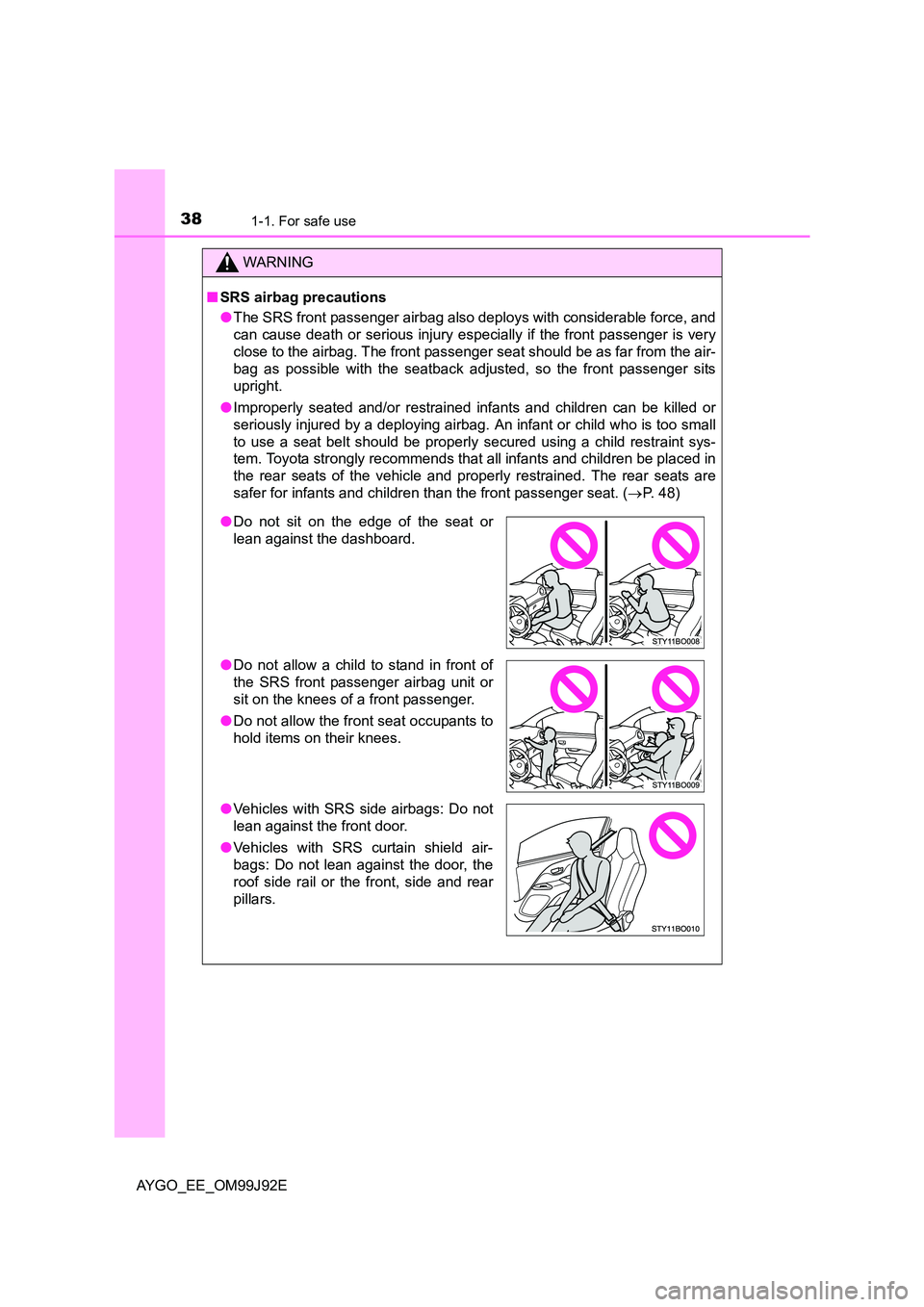
381-1. For safe use
AYGO_EE_OM99J92E
WARNING
■ SRS airbag precautions
● The SRS front passenger airbag also deploys with considerable force, and
can cause death or serious injury especially if the front passenger is very
close to the airbag. The front passenger seat should be as far from the air-
bag as possible with the seatback adjusted, so the front passenger sits
upright.
● Improperly seated and/or restrained infants and children can be killed or
seriously injured by a deploying airbag. An infant or child who is too small
to use a seat belt should be properly secured using a child restraint sys-
tem. Toyota strongly recommends that all infants and children be placed in
the rear seats of the vehicle and proper ly restrained. The rear seats are
safer for infants and children than the front passenger seat. ( →P. 48)
●Do not sit on the edge of the seat or
lean against the dashboard.
● Do not allow a child to stand in front of
the SRS front passenger airbag unit or
sit on the knees of a front passenger.
● Do not allow the front seat occupants to
hold items on their knees.
● Vehicles with SRS side airbags: Do not
lean against the front door.
● Vehicles with SRS curtain shield air-
bags: Do not lean against the door, the
roof side rail or the front, side and rear
pillars.
Page 41 of 440

411-1. For safe use
1
For safety and security
AYGO_EE_OM99J92E
■If the SRS airbags deploy (inflate)
● Bruising and slight abrasions may result from contact with a deploying
(inflating) SRS airbag.
● A loud noise and white powder will be emitted.
● Vehicles without SRS curtain shield airbags: Parts of the airbag module
(steering wheel hub, airbag cover and inflator) as well as the front seats may
be hot for several minutes. The airbag itself may also be hot.
● Vehicles with SRS curtain shield airbags: Parts of the airbag module (steer-
ing wheel hub, airbag cover and inflator) as well as the front seats, parts of
the front and rear pillars, and roof side rails, may be hot for several minutes.
The airbag itself may also be hot.
● The windshield may crack.
■ SRS airbag deployment conditions (SRS front airbags)
● The SRS front airbags will deploy in the event of an impact that exceeds the
set threshold level (the level of force corresponding to an approximately
20 - 30 km/h [12 - 18 mph] frontal collision with a fixed wall that does not
move or deform).
However, this threshold velocity will be considerably higher in the following
situations:
• If the vehicle strikes an object, such as a parked vehicle or sign pole,
which can move or deform on impact
• If the vehicle is involved in an underride collision, such as a collision in
which the front of the vehicle “underrides”, or goes under, the bed of a
truck
● Depending on the type of collision, it is possible that only the seat belt pre-
tensioners will activate.
■ SRS airbag deployment conditions (SRS side airbags) (if equipped)
The SRS side airbags will deploy in the event of an impact that exceeds the
set threshold level (the level of force corresponding to the impact force pro-
duced by an approximately 1500 kg [3300 lb.] vehicle colliding with the vehi-
cle cabin from a direction perpendicular to the vehicle orientation at an
approximate speed of 20 - 30 km/h [12 - 18 mph]).
■ SRS airbag deployment conditions (SRS side and curtain shield airbags)
(if equipped)
● The SRS side and curtain shield airbags will deploy in the event of an
impact that exceeds the set threshold level (the level of force corresponding
to the impact force produced by an approximately 1500 kg [3300 lb.] vehicle
colliding with the vehicle cabin from a direction perpendicular to the vehicle
orientation at an approximate speed of 20 - 30 km/h [12 - 18 mph]).
● The SRS curtain shield airbags may also deploy in the event of a severe
frontal collision.
Page 89 of 440
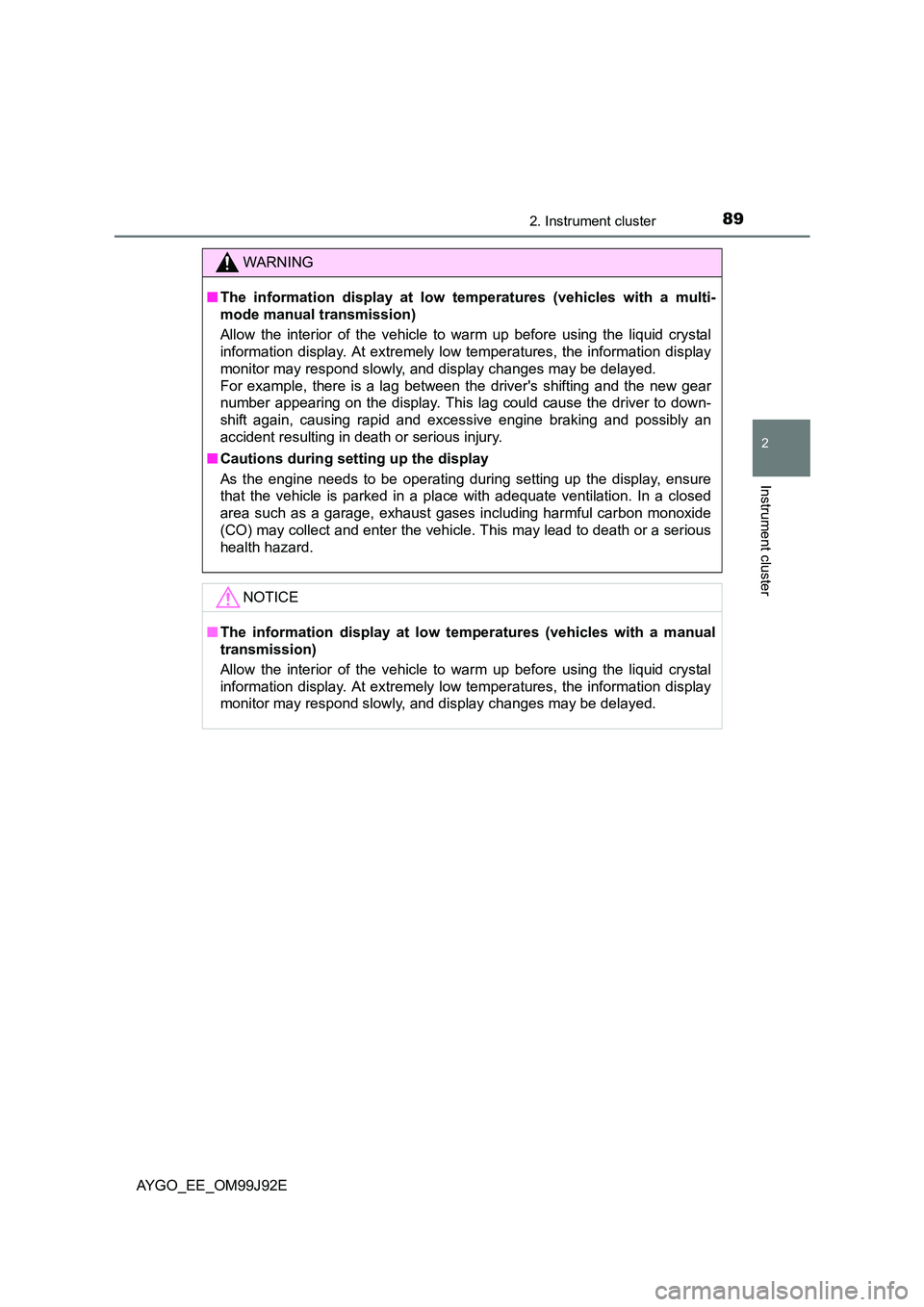
892. Instrument cluster
2
Instrument cluster
AYGO_EE_OM99J92E
WARNING
■ The information display at low temperatures (vehicles with a multi-
mode manual transmission)
Allow the interior of the vehicle to warm up before using the liquid crystal
information display. At extremely low temperatures, the information display
monitor may respond slowly, and display changes may be delayed.
For example, there is a lag between the driver's shifting and the new gear
number appearing on the display. This lag could cause the driver to down-
shift again, causing rapid and excessive engine braking and possibly an
accident resulting in death or serious injury.
■ Cautions during setting up the display
As the engine needs to be operating during setting up the display, ensure
that the vehicle is parked in a place with adequate ventilation. In a closed
area such as a garage, exhaust gases including harmful carbon monoxide
(CO) may collect and enter the vehicle. This may lead to death or a serious
health hazard.
NOTICE
■ The information display at low temperatures (vehicles with a manual
transmission)
Allow the interior of the vehicle to warm up before using the liquid crystal
information display. At extremely low temperatures, the information display
monitor may respond slowly, and display changes may be delayed.
Page 106 of 440
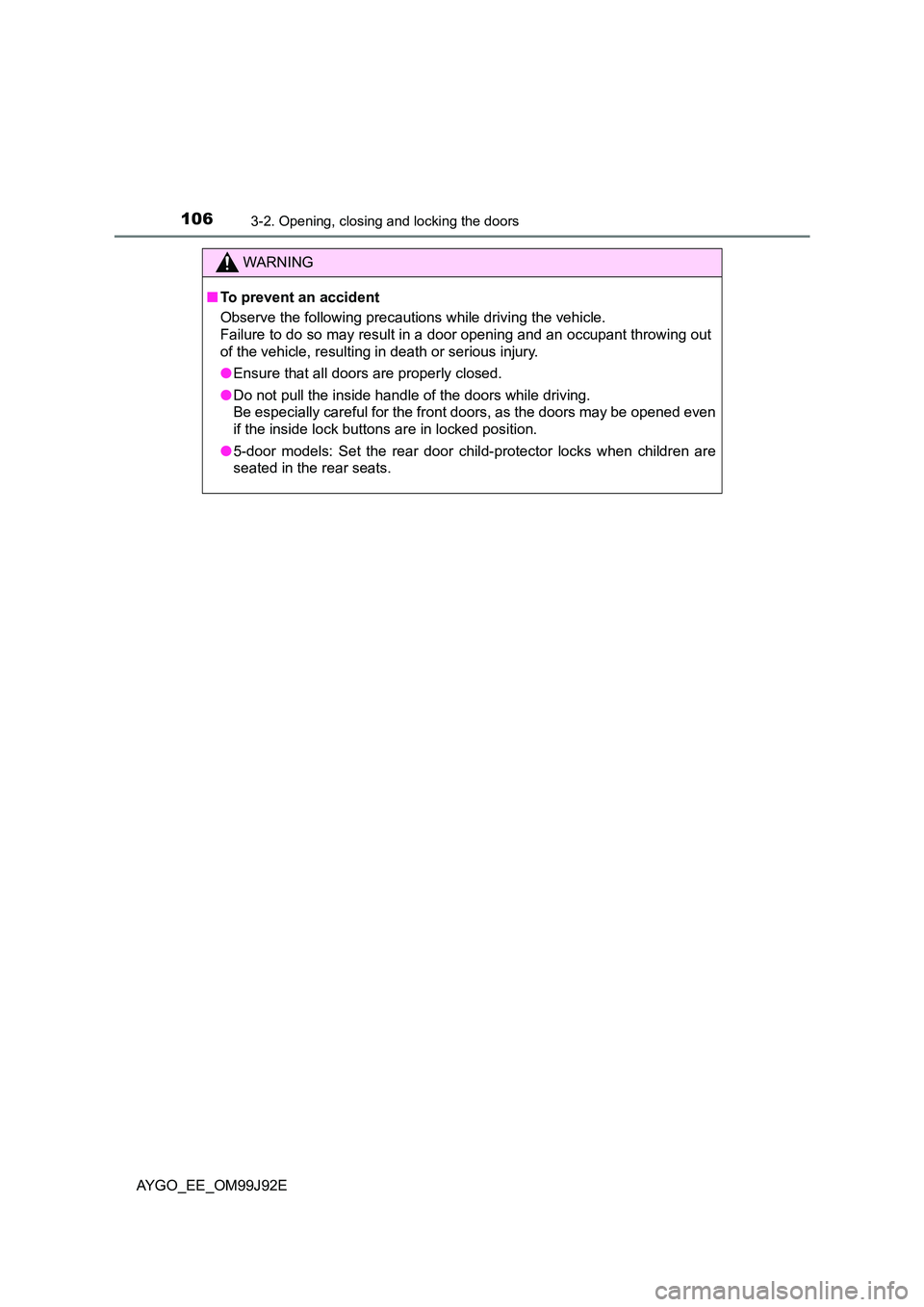
1063-2. Opening, closing and locking the doors
AYGO_EE_OM99J92E
WARNING
■ To prevent an accident
Observe the following precautions while driving the vehicle.
Failure to do so may result in a door opening and an occupant throwing out
of the vehicle, resulting in death or serious injury.
● Ensure that all doors are properly closed.
● Do not pull the inside handle of the doors while driving.
Be especially careful for the front doors, as the doors may be opened even
if the inside lock buttons are in locked position.
● 5-door models: Set the rear door child-protector locks when children are
seated in the rear seats.
Page 127 of 440
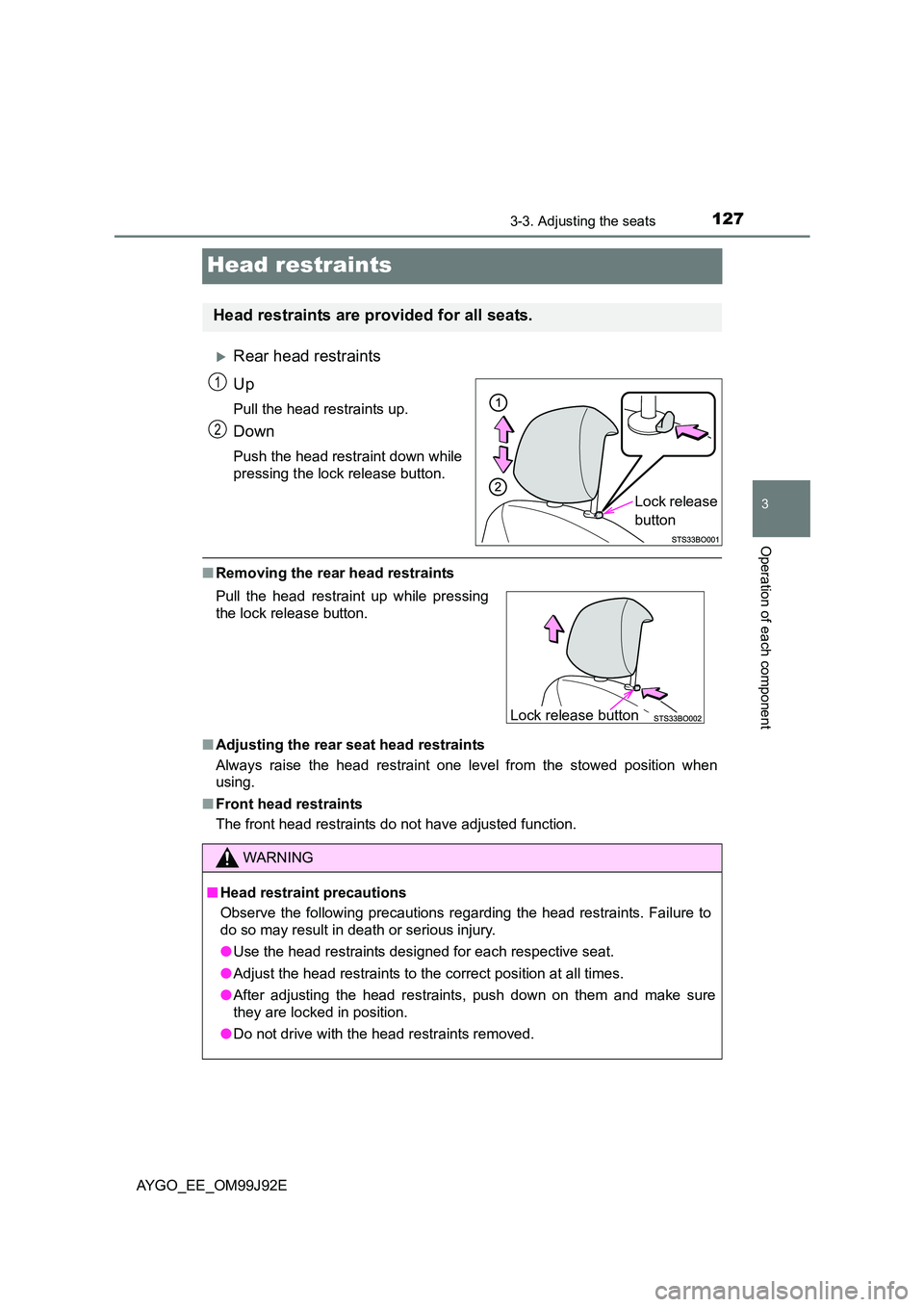
127
3
3-3. Adjusting the seats
Operation of each component
AYGO_EE_OM99J92E
Head restraints
�XRear head restraints
Up
Pull the head restraints up.
Down
Push the head restraint down while
pressing the lock release button.
■ Removing the rear head restraints
■ Adjusting the rear seat head restraints
Always raise the head restraint one level from the stowed position when
using.
■ Front head restraints
The front head restraints do not have adjusted function.
Head restraints are provided for all seats.
Lock release
button
1
2
Pull the head restraint up while pressing
the lock release button.
WARNING
■ Head restraint precautions
Observe the following precautions regarding the head restraints. Failure to
do so may result in death or serious injury.
● Use the head restraints designed for each respective seat.
● Adjust the head restraints to the correct position at all times.
● After adjusting the head restraints, push down on them and make sure
they are locked in position.
● Do not drive with the head restraints removed.
Lock release button
Page 133 of 440
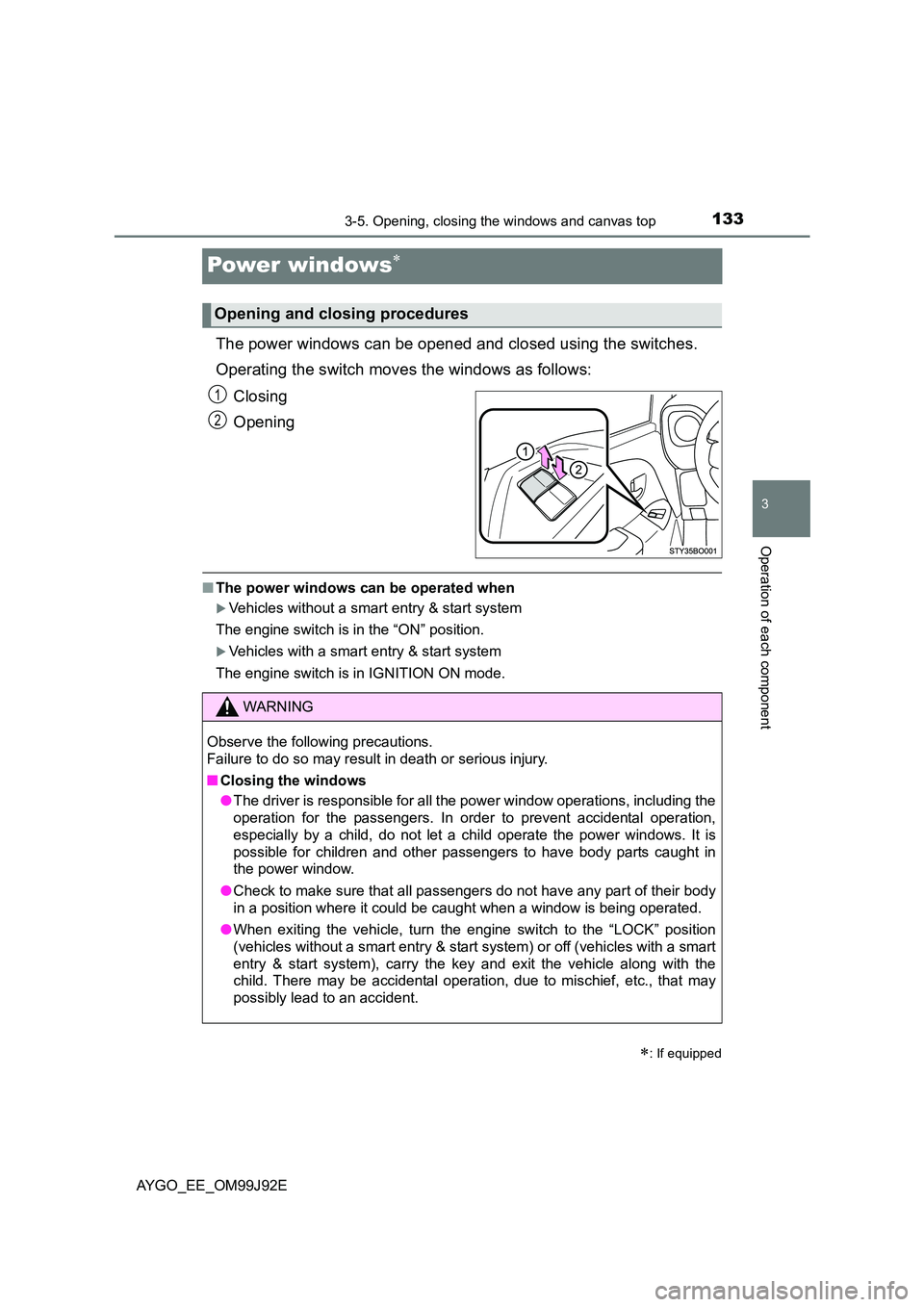
133
3
3-5. Opening, closing the windows and canvas top
Operation of each component
AYGO_EE_OM99J92E
Power windows∗
The power windows can be opened and closed using the switches.
Operating the switch moves the windows as follows:
Closing
Opening
■ The power windows can be operated when
�XVehicles without a smart entry & start system
The engine switch is in the “ON” position.
�XVehicles with a smart entry & start system
The engine switch is in IGNITION ON mode.
∗: If equipped
Opening and closing procedures
1
2
WARNING
Observe the following precautions.
Failure to do so may result in death or serious injury.
■ Closing the windows
● The driver is responsible for all the power window operations, including the
operation for the passengers. In order to prevent accidental operation,
especially by a child, do not let a child operate the power windows. It is
possible for children and other passengers to have body parts caught in
the power window.
● Check to make sure that all passengers do not have any part of their body
in a position where it could be caught when a window is being operated.
● When exiting the vehicle, turn the engine switch to the “LOCK” position
(vehicles without a smart entry & start system) or off (vehicles with a smart
entry & start system), carry the key and exit the vehicle along with the
child. There may be accidental operation, due to mischief, etc., that may
possibly lead to an accident.
Page 137 of 440
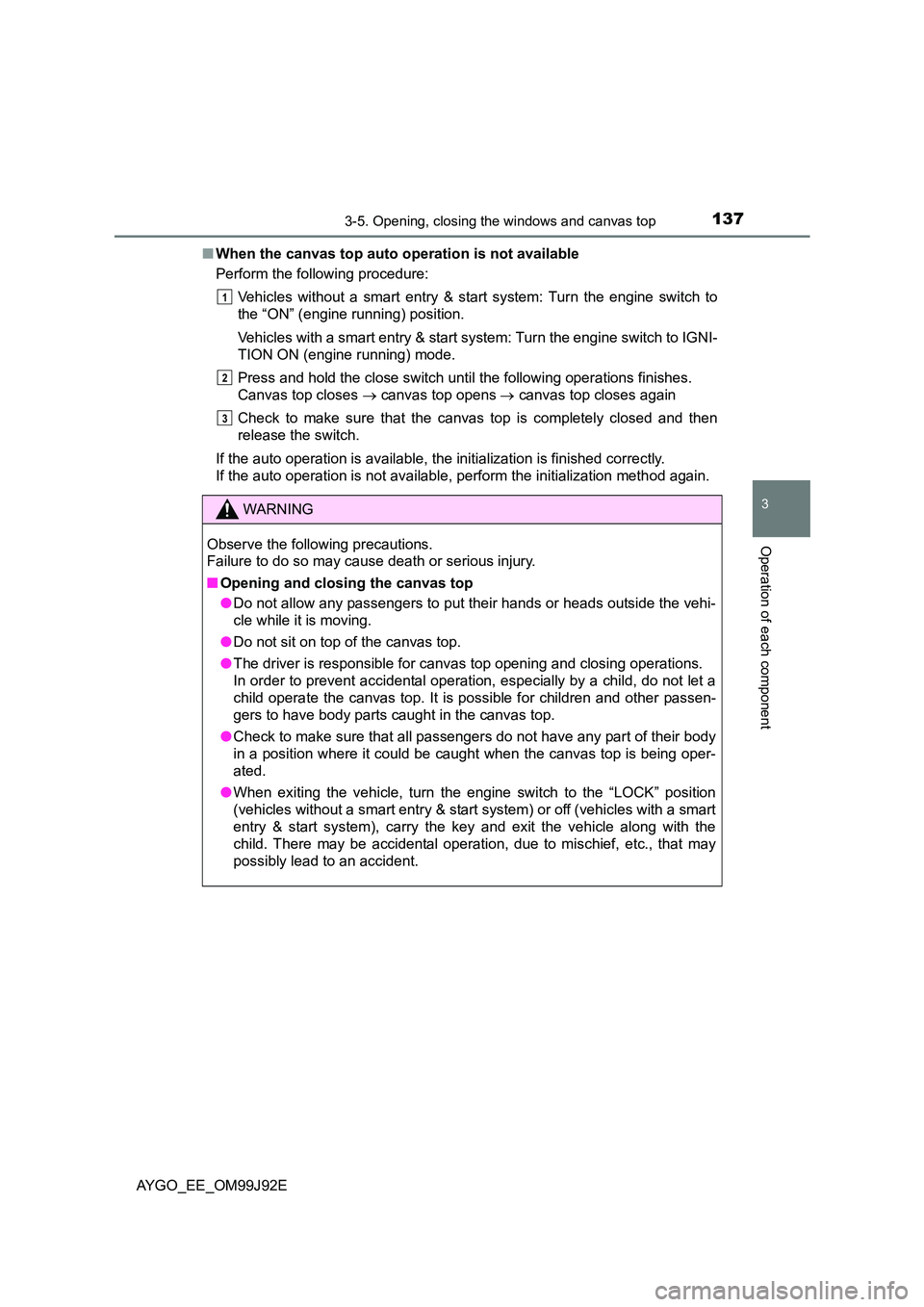
1373-5. Opening, closing the windows and canvas top
3
Operation of each component
AYGO_EE_OM99J92E
■ When the canvas top auto operation is not available
Perform the following procedure:
Vehicles without a smart entry & start system: Turn the engine switch to
the “ON” (engine running) position.
Vehicles with a smart entry & start system: Turn the engine switch to IGNI-
TION ON (engine running) mode.
Press and hold the close switch until the following operations finishes.
Canvas top closes → canvas top opens → canvas top closes again
Check to make sure that the canvas top is completely closed and then
release the switch.
If the auto operation is available, the initialization is finished correctly.
If the auto operation is not available, perform the initialization method again.
WARNING
Observe the following precautions.
Failure to do so may cause death or serious injury.
■ Opening and closing the canvas top
● Do not allow any passengers to put their hands or heads outside the vehi-
cle while it is moving.
● Do not sit on top of the canvas top.
● The driver is responsible for canvas top opening and closing operations.
In order to prevent accidental operation, especially by a child, do not let a
child operate the canvas top. It is possible for children and other passen-
gers to have body parts caught in the canvas top.
● Check to make sure that all passengers do not have any part of their body
in a position where it could be caught when the canvas top is being oper-
ated.
● When exiting the vehicle, turn the engine switch to the “LOCK” position
(vehicles without a smart entry & start system) or off (vehicles with a smart
entry & start system), carry the key and exit the vehicle along with the
child. There may be accidental operation, due to mischief, etc., that may
possibly lead to an accident.
1
2
3
Page 142 of 440
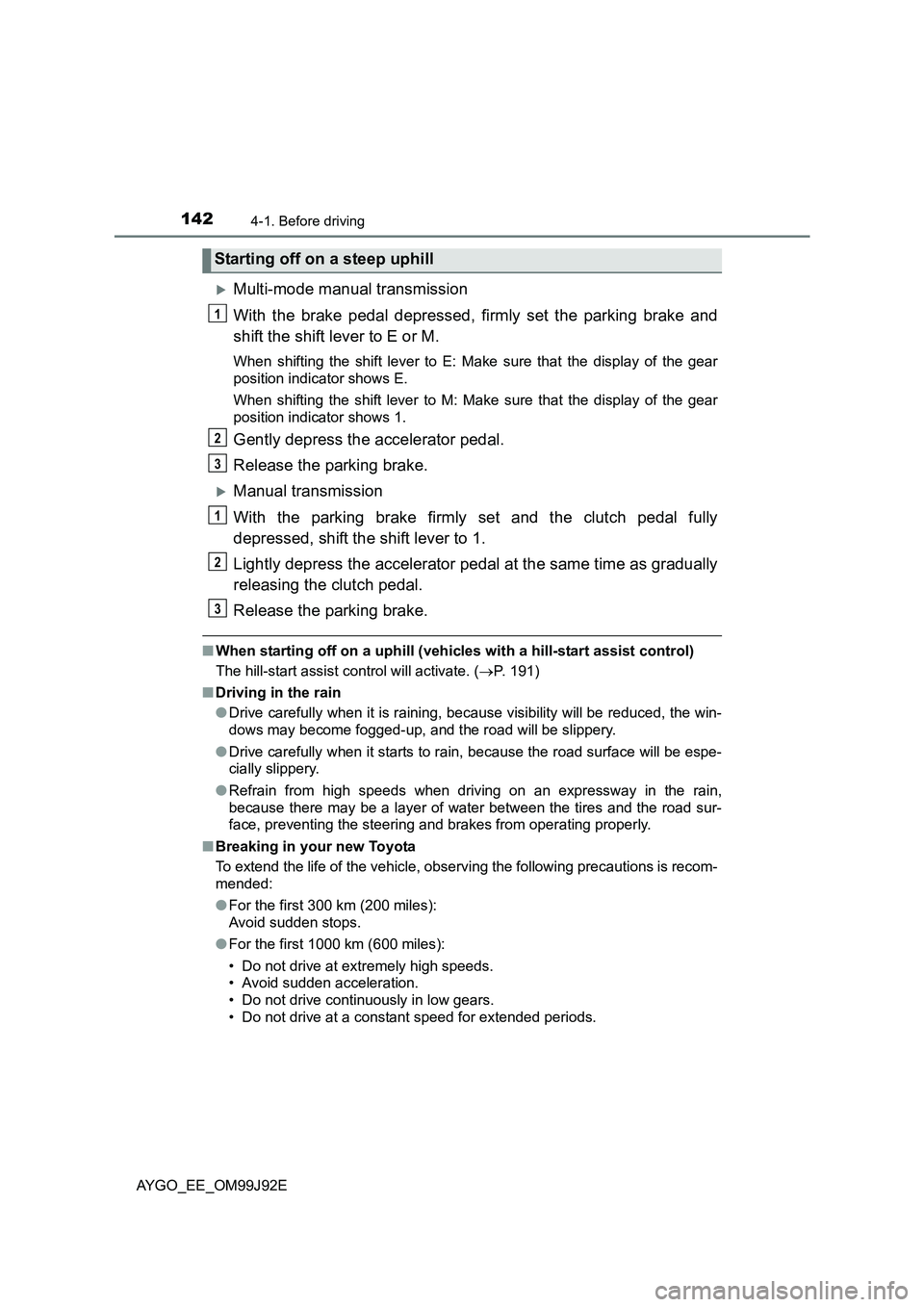
1424-1. Before driving
AYGO_EE_OM99J92E
�XMulti-mode manual transmission
With the brake pedal depressed, firmly set the parking brake and
shift the shift lever to E or M.
When shifting the shift lever to E: Make sure that the display of the gear
position indicator shows E.
When shifting the shift lever to M: Make sure that the display of the gear
position indicator shows 1.
Gently depress the accelerator pedal.
Release the parking brake.
�XManual transmission
With the parking brake firmly set and the clutch pedal fully
depressed, shift the shift lever to 1.
Lightly depress the accelerator pedal at the same time as gradually
releasing the clutch pedal.
Release the parking brake.
■ When starting off on a uphill (vehicles with a hill-start assist control)
The hill-start assist control will activate. ( →P. 191)
■ Driving in the rain
● Drive carefully when it is raining, because visibility will be reduced, the win-
dows may become fogged-up, and the road will be slippery.
● Drive carefully when it starts to rain, because the road surface will be espe-
cially slippery.
● Refrain from high speeds when driving on an expressway in the rain,
because there may be a layer of water between the tires and the road sur-
face, preventing the steering and brakes from operating properly.
■ Breaking in your new Toyota
To extend the life of the vehicle, observing the following precautions is recom-
mended:
● For the first 300 km (200 miles):
Avoid sudden stops.
● For the first 1000 km (600 miles):
• Do not drive at extremely high speeds.
• Avoid sudden acceleration.
• Do not drive continuously in low gears.
• Do not drive at a constant speed for extended periods.
Starting off on a steep uphill
1
2
3
1
2
3